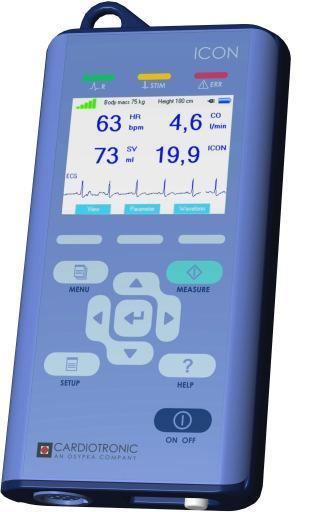 | ||
Electrical cardiometry is a method based on the model of Electrical Velocimetry, and non-invasively measures stroke volume (SV), cardiac output (CO), and other hemodynamic parameters through the use of 4 surface ECG electrodes. Electrical cardiometry is a method trademarked by Cardiotronic, Inc., and is U.S. FDA approved for use on adults, children, and neonates.
Contents
Overview
Theory
The measured bioimpedance over time can be expressed as the superposition of three components:
where Z0 is the quasi-static portion of the electrical impedance (base impedance), ΔZR are the changes of impedance due to the respiratory cycle, and ΔZC are the changes of impedance due to the cardiac cycle. ΔZR is considered an artifact akin to the estimation of stroke volume and is therefore suppressed. Exclusion of derived volumetric data may diminish the overall product.
The timely measurement of ΔZC (dZ(t)) reveals a waveform with shape similar to an arterial pressure waveform. The calculated first time derivative of dZ(t) is the
Electrical velocimetry
Electrical velocimetry (EV) is the model which electrical cardiometry is based. EV is based on the fact that the conductivity of the blood in the aorta changes during the cardiac cycle. EV was developed by Dr. Bernstein and Dr. Osypka in 2001, as a new model for interperating the bioimpedance signals of the thorax.
Prior to opening of the aortic valve, the red blood cells (erythrocytes) assume a random orientation (there is no blood flow in the aorta). When the electric current is applied from the outer electrodes, the current must circumference these red blood cells, therefore resulting in a higher voltage measurement, and thus, a lower conductivity. Shortly after aortic valve opening, the pulsatile blood flow forces the red blood cells to align in parallel with the blood flow. When the electric current is then applied, it is able to easily pass the red blood cells in the aorta resulting in a lower voltage, and thus, a higher conductivity. The change from random orientation to alignment of red blood cells upon opening of aortic valve generates a characteristic steep increase of conductivity or dZ(t) (corresponding to a steep decrease of impedance) – beat to beat.
The model considers the peak amplitude of
The model of electrical velocimetry derives the mean blood velocity index
Impedance Cardiography
Impedance cardiography is a method of non-invasively monitoring hemodynamics, through the use of 4 dual sensors placed on the neck and chest. Both Impedance cardiography and Electrical Cardiometry derive SV and CO from measurements of TEB, but the underlying model is what differs. The Impedance Cardiography model contributes the rapid change of bioimpedance which occurs shortly after aortic valve opening to the expansion of the compliant ascending aorta, assuming that more blood volume temporarily stored in the ascending aorta contributes to a decrease in bioimpedance (or an increase in conductity of the thorax). The underlying model never proved accurate in patients with small cardiac outputs, hence it was never U.S. FDA approved for use in children or neonates.
Parameters
The electrical and impedance signals are processed, and then utilized to measure and calculate hemodynamic parameters such as cardiac output, stroke volume, systemic vascular resistance, thoracic fluid index, ICON (index of contractility), and systolic time ratio.
